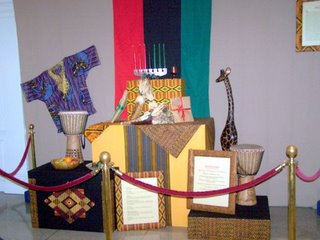Holidays Around the World: United States


the carolers that sang in the America Pavilion were amazing. they sang quite a few traditional carols & the acoustics of the domed room made their perfect harmony sound even more amazing. but the America Pavilion also had stations for the other two holidays that are celebrated around the same time as Christmas & i found it interesting to learn a little bit more than just the basics about them as well.
Chanukah (or Hanukkah) is the Festival of Lights. as the story goes, in 165 BC, with the help of the neighboring Hasideans, the Maccabees defeated the vastly superior forces of the Syrian King and liberated the city of Jerusalem. upon entering the Central Synagogue, the Maccabees discovered that the temple had been desecrated with the blood & bodies of slain pigs. the sacred Torah scrolls had been burned. the containers of holy oil for the Eternal Flame were overturned & spilled on the ground. one small bottle containing a single day's worth of olive oil was discovered intact. the flame was lit using the existing oil & the reconstruction of the temple began. at least eight days were required to send for & receive mroe oil for preserving the Eternal Flame. the flame burned for the entire eight days, time enough to build a new altar & sanctify the temple. this was Chanukah instituted by the Maccabees. the eight day celebration begins on the eve of the 25th day of the Hebrew month of Kislev (December). one candle on a Menorah is lit each day to commemorate the "miracle of Chanukah" until all eight candles are burning on the last night. though it was traditional to give "gelt" (Yiddish for "money") or foil-wrapped chocoalte coins to children during Hanukkah, in many families this has changed into exchanging gifts, similar to the tradition associated with Christmas.
the dreidel, a four-sided toy marked with Hebrew letters & spun like a top in a game of chance, was created to help tell children the story of Chanukah. the Hebrew lettes that are engraved on the sides of the dreidel are "Nun," "Gimel," "Hey," and "Shin" -- these letters are an acronym for the Hebrew words "Nes Gadol Haya Sham" (A great miracle happened there). to play the game, each player starts out with 10 or 15 coins, nuts or other markers, and places one marker into the "pot." The first player spins the dreidel, which lands with one of its symbols facing up, indicating the appropriate action to be taken, corresponding to one of the following Yiddish words. the dreidel game is played in part to commemorate a game that the Jews under Greek domination played to camouflage their Torah study. though the Greeks made a law forbidding the study of Torah, the Jews would gather in caves to engage in learning. a lookout was posted to alert the group to the presence of Greek soldiers. if one was spotted, he would give a signal & the Jews would hide their scrolls & begin playing with dreidels & coins, giving the impression that they were engaged in gambling, not learning.
another holiday that has begun receiving attention in the United States is Kwanzaa. Kwanzaa is an African-American festival to celebrate harvest & community. it has its roots in the civil rights era of the 1960s. Kwanzaa, which means "first fruits," is not a religious holiday but a distinctly cultural celebration based on traditional African harvest festivals. it was founded as a way of reaffirming African-American identity, instilling knowledge & pride in African roots, and reinforcing bonds among members of the community. Kwanzaa is devoted to seven principles: Unity. Self-determination. Collective Work & Responsibility. Cooperative Economics. Purpose. Creativity. Faith. during the weeklong event, which take place from December 26 through January 1, celebrants decorate their homes in black, green, and red (the colors of the African flag), and wear tradtional head gear, beads & African dress. they reflect on the year that is ending, celebrate their African-American heritage, and practice traditional African community & family values. each day is dedicated to one of the seven principles. in the evening, family members gather to light one of the seven candles, each symbolizing one of these principles, discuss that day's principle, and receive gifts. near the end of Kwanzaa, a feast is held, featuring African food, music, and dancing. although it was first observed solely by African Americans, Kwanzaa is now celebrated by an estimated 18 million people in the United States, Canada, the Caribbean, Britain, India and some African nations.
some of the traditional symbols of Kwanzaa are:
MAZAO: the fruits & vegetables of the harvest
MUHINDI: one ear of dry corn for each child living in the household
KIKOMBE CHA UMOJA: a simple wooden cup symbolizing unity that is used to drink to the honor of the ancestors
KINARA: a simple handmade holder for seven candles
MISHIUMAA SABA: the seven candles (3 red, 3 green, 1 black) of Kwanzaa which represent the seven principles
ZAWADI: Kwanzaa gifts that parents give to their children










1 with their own thoughts:
what a great post! isn't it nice when you can have fun and learn something at the same time??
Post a Comment